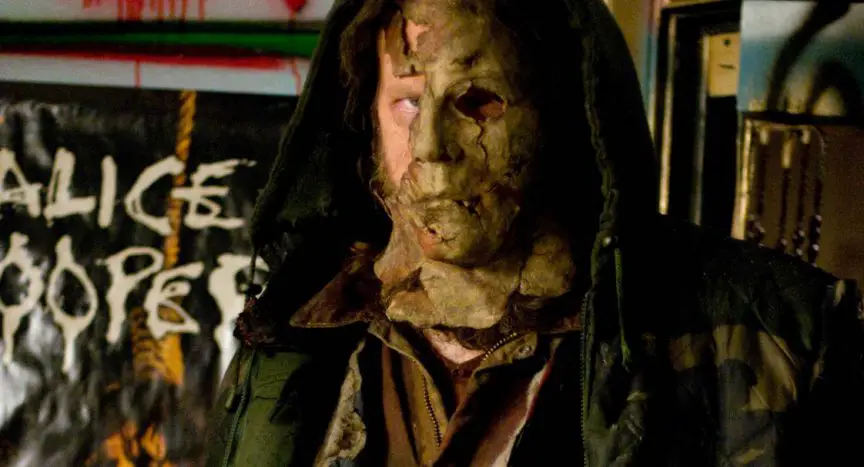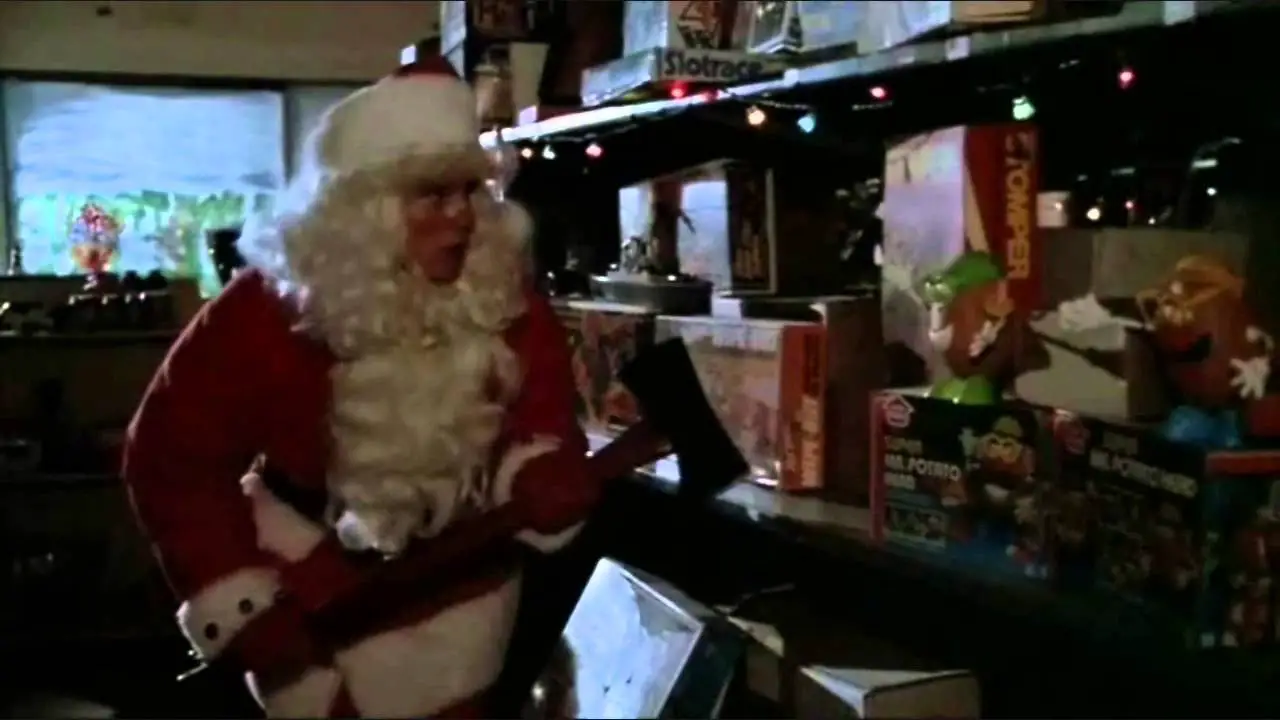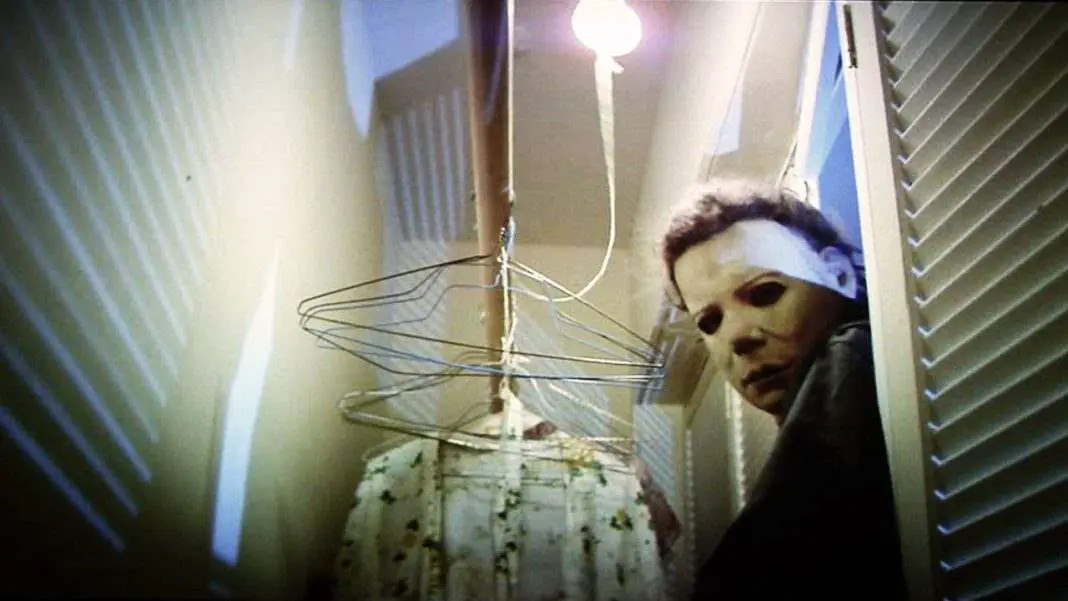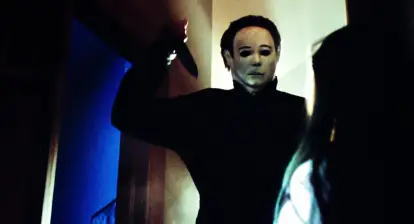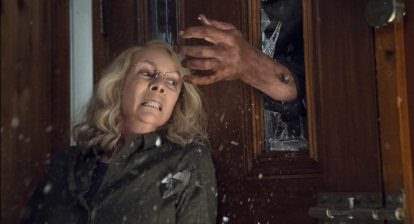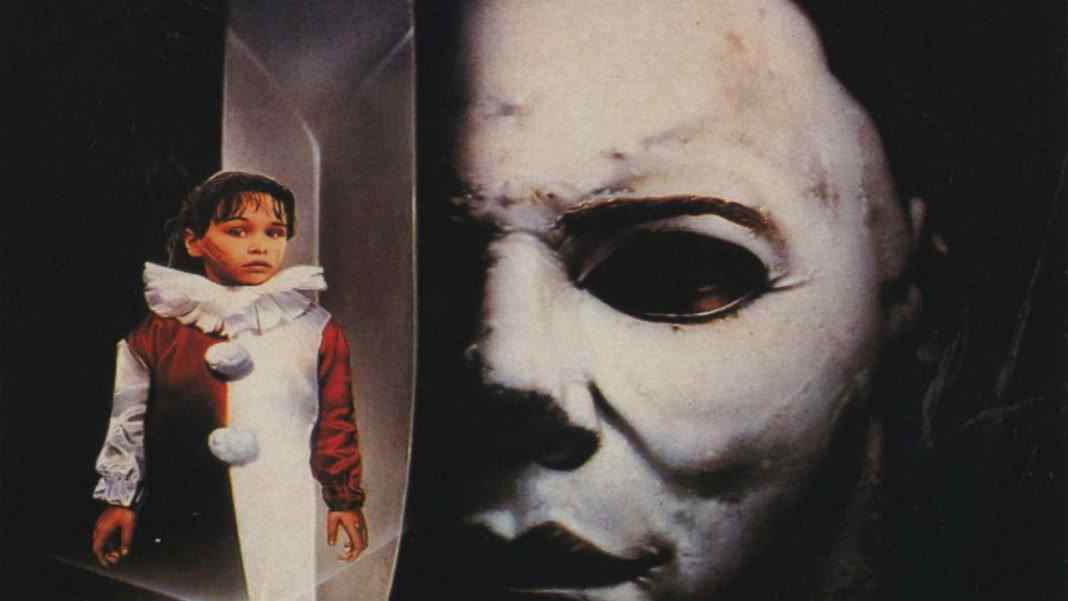Halloween II was not a film Rob Zombie wanted to make. Industry suggests he was coerced into doing so by the Weinsteins, who promised him that magnum opus Tyrannosaurus Rex would be next. A decade later, we still haven’t seen it. But Halloween II is 10 this week and deserves some attention. First things first, the poster art for this flick sucks. It’s actually the DVD menu too, if you’re lucky enough to own a copy (I found one in a CEX and the cover actually fell off when I took it out for a recent re-watch, so the previous owner clearly got a lot of use out of it), and sees Michael Myers…in a field? Grabbing…some grass? It’s very weird and completely symptomatic of the 2000s trend of making things look very slick and yet completely low-rent at the same time.
Halloween II has an identity crisis of sorts, which makes more sense knowing Zombie didn’t want to do it in the first place. It opens in a mental asylum, with young Mike and his mother (Sheri Moon Zombie, trying to rein it in a little since she’s not wearing ass-less chaps), now apparently a saint rather than a stripper, having a clunky conversation about family. The theme of this movie, you see, is family is forever. Even murder-y families.
This wholly unnecessary reintroduction thankfully soon gives way to a much more exciting sequence, which sees a bloodied Laurie Strode limping, gun in hand, down the road before being taken to hospital where she wails incessantly on a gurney as doctors and nurses attend to her. It’s rare we get to see the aftermath of violent crimes in horror movies, so the cleanup element is definitely interesting.
Related: Frightfest 2016 Review: Rob Zombie’s 31
The moments when Laurie is chased through the hospital by a stab-happy Michael, which pay homage to the original Halloween II, are strong and well-done — in fact, this is probably the strongest, and most cohesive, sequence in the whole movie. Watching poor Laurie trying to get away from a deliberately strolling Michael is terrifying, and Zombie deviously moves her slowly from ward to the rain-soaked outside and finally into a shack with a kindly Richard Riehle who, sadly, we know won’t survive very long.
When Mike is hacking away at the structure as Laurie cowers under a desk, a nearby TV hinting this is all a dream because the same music video is playing as earlier in her room, Zombie lets the scene drag on for longer than feels necessary. It’s uncomfortable, but it’s very clever too. We’re waiting for that respite, for him to stop hacking and just get to her already, but Zombie takes his time. It’s no surprise this was the sequence that sold the movie in its trailer (which I watched over and over again on a loop, terrified, while living in Germany with very little Internet access).
Halloween II is super slick. It’s very much a Dimension horror from the 2000s, indecipherable in color palette from virtually anything else released in the years surrounding it. But this is still a Rob Zombie film and, to that end, he keeps things nastier and grislier than any Halloween movie has ever been, or could ever be (Halloween 2018 does boast that brilliant head smushing, though). His Mike saws off someone’s head with a piece of broken glass, Zombie zooming in to catch all the little tendons snapping. The head in question belongs to Richard Brake, who was recommended by one Sid Haig and who has since become a regular Zombie collaborator (his opening monologue in 31 is truly brilliant).
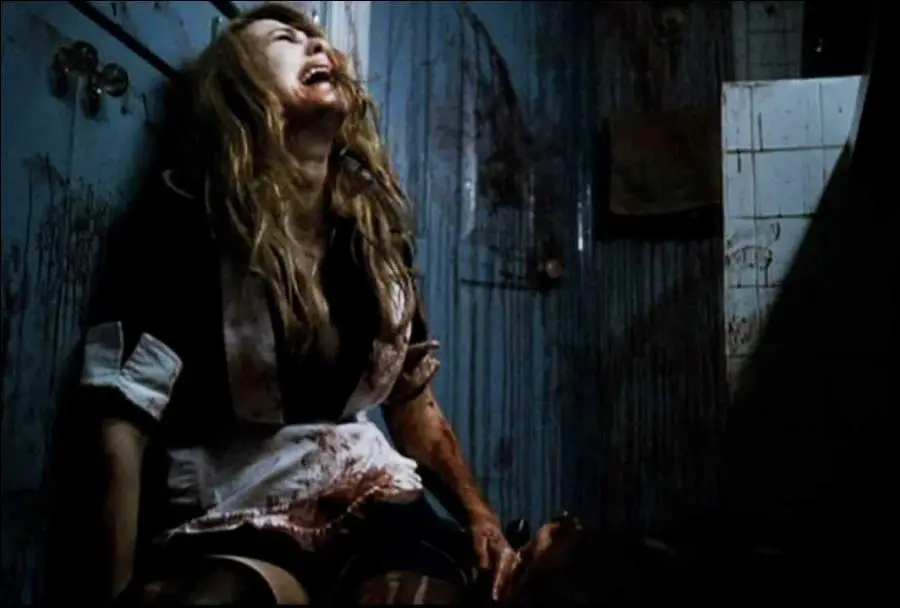
As usual, the great man has assembled a terrific cast including Brad Dourif as Sherriff Brackett, Danielle Harris as his daughter, Annie (Harris will most likely play teenagers until she’s in her eighties — maybe even past then), Jeff Daniel Phillipps in two roles, neither of which is a Zombie stand-in, sadly, Oscar winner Octavia Spencer, who would later show up in Blumhouse dud Ma, and, most important of all for this particular story, Malcolm McDowell as Loomis.
Here, unlike in Halloween where he was a sweet, well-meaning psychiatrist, Loomis is a total asshole, profiting off the fame he garnered by working with Michael Myers. He’s reintroduced riding around town in a limo, basking in the glory of his newfound notoriety. Loomis yells at his assistant for using an old photo of him (in the original Loomis coat, which is quite funny) and consistently chastises her for suggesting he might be going too far during the publicity tour for his new, tell-all book.
Zombie doesn’t give Loomis his big hero moment until the final act. Until then, McDowell plays him as a slimy, uncaring, and money-grabbing opportunist who gets schooled by Weird Al of all people (“Mr Weird,” Loomis hilariously greets him) and, in one truly horrifying moment, is confronted by Linda’s father during a book signing. The man pulls out a gun and Loomis is visibly shaken, but he isn’t sorry — certainly not sorry enough to not stage an interview outside the old Myers house, again against his assistant’s wishes.
This is a Loomis we’ve never seen before, a modern Loomis who cares more about being in the limelight than keeping Haddonfield and particularly poor Laurie safe. When it came time to introduce a new doctor character in the Halloween reboot, the filmmakers went even further, making the man a lunatic super-fan of Myers himself who seeks to emulate him. Zombie doesn’t quite go that far, but his take on the beloved character reads even more prescient nowadays than it did back in 2009, particular considering how Wes Craven tackled fame-hungry teens in Scream 4 just a couple years later.
Zombie took a lot of flak for making Michael a huge, imposing, almost otherworldly presence in 2007’s Halloween but he, too, is a modern take on a classic character. There’s a great idea of size here, from his big, heavy boots coming slowly out of a van to how the killer towers over an unsuspecting child, who questions whether he’s a giant. Ex-wrestler Tyler Mane looks a bit silly traipsing through fields with his bag, coat, and jeans (one character calls him a “filthy, dirty hippie,” which seems fitting) but the fear comes from nobody realizing who he actually is.
Zombie’s Mike is slow and methodical. He kills for pleasure, and with great ease. He doesn’t always wear his mask, which is a brave choice that makes sense when the dude is sporting a massive beard and long hair (this Mike looks like Slipknot — not any one member, either, but the whole band). In the director’s cut, Zombie’s Mike even speaks, yelling “Die!” before stabbing Loomis which is, er, certainly a choice.

One of the weirdest moments of Halloween II finds Mike chowing down on a dog he’s just killed, which leads to a very strange suggestion that he and Laurie share some kind of, how do I put this, tummy connection as she throws up simultaneously across town. Later, he lifts a car. The implication is this version of Michael Myers is rougher and more unstoppable than ever, which is funny considering a regular dude with a knife in a white mask used to be enough for us.
Zombie grew up obsessing over Halloween so it stands to reason he would try to, first, explain his backstory (in his own remake) and then elaborate further on what makes this character so terrifying to a modern audience. His Mike is really stabby, to an insane extent, but mid-2000s audiences were in the midst of a torture porn epidemic and jonesing for bigger and harder kills. Also, this is RZ, so he’s never going to scrimp on the violence.
Halloween II isn’t as over-the-top nuts or messy as House of 1000 Corpses, however. There are certainly moments where Zombie’s choices are more interesting, like when he places the camera in weird spots so he can shoot through stuff and make it seem like someone, or something, is always leeringly watching his characters. The many dream-based set-pieces are nicely staged, suggesting imagery we’d later see in Lords of Salem, which is perhaps Zombie’s most cohesive and best looking film.
Halloween II has maybe two jump scares overall, which is virtually unheard of in a modern horror movie of this time period. The shot of Mike in the mirror, as an unassuming Annie washes up at the sink, is bone-chilling to the point you almost wish Zombie had played with putting this massive dude in the background a bit more, rather than always relying on him just lumbering into the shot (it’s a long ol’ road to Haddonfield, eh?).
Plenty of slo-mo is employed, particularly for kills which, again, feels like a strange choice but is oddly fitting in a movie loaded with deliberately bizarre stuff. Zombie makes the controversial choice to kill Danielle Harris in a Halloween movie for the first and only time, giving her a violent, bloody death and an emotionally charged moment with a devastated Laurie to send her off in style.
The friendship between Annie and Laurie is fleshed out more in the director’s cut, where they have proper arguments with each other, but Zombie gives us enough here to establish they’re keeping each other going as the two young women deal very differently with what’s happened to them. Annie continues on with life, trying to find a sense of normalcy with her father and new sort-of sister. Laurie, on the other hand, completely crumbles.

We’ve seen PTSD-addled Laurie in Halloween H20 and, in a much more refined variation, in 2018’s Halloween. But, in keeping with Zombie’s rough-and-ready aesthetic, here she’s not a grown woman with a load of scars, both literal and metaphorical, but a confused, depressed teenager riddled with nightmares who can barely hold down a job (side note: what does that store sell, and do these stores exist only in movies? Discuss) and who lashes out and runs away upon discovering who she really is.
Scout Taylor Compton sells the hell out of this modern version of Laurie, with her permanently un-brushed hair, lack of makeup, and disregard for anything or anybody in her life. She’s dependent on meds, but can’t put into words what’s really bothering her during difficult sessions with her therapist. The only times she really seems happy are when she’s with the Bracketts, rocking out with her friends at work, or when Laurie finally decides to cut loose and throw off her good girl image to party and forget (an interesting line that hearkens back to the 1978 variation in a very meaningful way).
The party is a classic venue for kills in slasher movies, but here Zombie uses it to show off a horror-themed band, some hot, topless ladies, his female characters’ rad Rocky Horror costumes and, most annoyingly, Uncle Seymour Coffins, a Svengoolie-like host with (deliberately?) bad jokes who, if you own the DVD, you can see more of as a special feature! Uncle Seymour Coffins is the weirdest addition to an already weird film. Who would want to see more of him? Why doesn’t he get killed? Why is he there at all?
See Also: Halloween (2018) is a Welcome Return to Form [Blu-Ray Review]
There are lots of fun little details in Halloween II, from Laurie listening to Diamond Head’s “Am I Evil?” in her car after learning who she really is, to her putting on Michael’s mask (which must stink, to be fair) at the end of the movie after finally, maybe giving in to her basest feelings. However, the very literal metaphor with Mike’s mother and the white horse, as well as his younger self who can talk when the adult version never does (“Go have some fun,” she instructs, to which the kid replies deadpan, “Okay”), is clunky as all hell. It keeps the action moving along but doesn’t add much of anything else, particularly given how deadly serious it is.
When it’s revealed that Laurie can see them too, it’s unclear what exactly we were supposed to be taking from their inclusion for the rest of the movie. Obviously, this revelation hints that Laurie is more Myers than she realizes, something that’s further confirmed by her telling Mike “I love you, brother” while he tries to hug her with a knife in his hand, and Laurie’s eventual relegation to a mental institution. The idea that Michael Myers is being goaded by paranoid visions of his mother and younger self is creepy, and it’s something many fans really like about Zombie’s Halloween II, but there is a strange clunkiness to it that never goes away.
Still, the little lick of the old Carpenter score we get at the end, followed by that great, nicely dark final shot of Laurie, ensures Halloween II doesn’t end on a bum note. In 2019, with last year’s genuinely terrific Halloween reboot in the rear-view, Zombie’s relentlessly nasty take on the myth of Michael Myers seems somewhat unrefined. His film’s great strength, however, lies in the depictions of Laurie and Loomis, two characters we thought we knew inside and out, who Zombie turns completely on their heads to create harsh, modern, and deliberately difficult takes that make us question everything about them.
